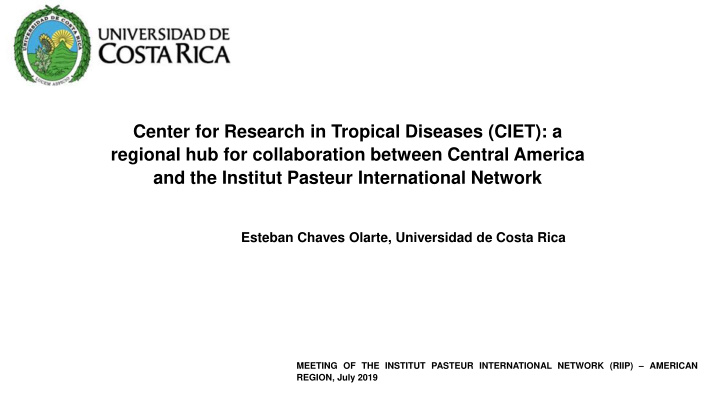



Center for Research in Tropical Diseases (CIET): a regional hub for collaboration between Central America and the Institut Pasteur International Network Esteban Chaves Olarte, Universidad de Costa Rica MEETING OF THE INSTITUT PASTEUR INTERNATIONAL NETWORK (RIIP) – AMERICAN REGION, July 2019
Research interests Clostridium difficile Brucelosis Arboviruses Malaria Xylella fastidiosa University of Costa Rica Faculty of Microbiology/CIET 40500 students 50 Active projects 545 academic programs Cancer 39 associated researchers 1400 research programs 291 Scientific publications, 1 patent (10 years) 284 international agreements Funding from national and international agencies Ranking QS: 19 in Latin America Strong links to post graduate programs
International cooperation and networking 1989-2013 2019-20XX NeTropica Javier Pizarro, Institut Pasteur
Diseases caused by Clostridium difficile Clinical spectrum Pathogenesis
Genetic diversity among C. difficile strains Core genome, 30%. High plasticity Variation in virulence potential NAP1/027 genotype Hipervirulent phenotype Fluoroquinolone resistance (gyrA mutation) Binary toxin tcdC deletion Increased TcdA and TcdB Increased sporulation TcdB variants He et al ., PNAS 2010 Scott et al ., JCM 2006
Outbreak of C. difficile in a Costarican hospital 45% NAP1 31% NAPCR1 (JCM, 2015, 53:1216)
NAP1 and NAPCR are unrelated virulent C. difficile strains NAPCR Clinical presentation NAP1 Virulence in hamster (JCM, 2015, 53:1216)
NAPCR does not hyper produce toxins NAPCR NAP1 Hipervirulent phenotype Hipervirulent phenotype Fluoroquinolone resistance Fluoroquinolone resistance (gyrA mutation) (gyrA mutation) Binary toxin tcdC deletion (no point mutation) tcdC deletion Increased TcdA and TcdB Increased sporulation TcdB variants HIPOTHESIS: NAPCR secretes additional molecules that synergize the action of the toxins
Toxins + Toxins - Toxin free supernatants from NAPCR strain are proinflammatory
Toxin free supernatant from NAPCR has increased proinflammatory activity Emerging virulent strain Resistant to fluoroquinolone Novel virulence mechanism
Other contributions in C. difficile
Molecular sensors to detect flavivirus multiplication Caspase activatable-GFP (CA-GFP) J. Biol. Chem. 2011, 286: 24977-86
The NS3A-GFP/Flavi reporter becomes fluorescent upon cleavage by DENV/ZIKV proteases in cell-free system tGFP/control: Arias-Arias et al. (2017) Unpublished data
The NS3A-GFP/Flavi reporter becomes cleaved and fluorescent into stably transduced mammalian cells upon flaviviral infection Arias-Arias et al. (2018) Unpublished data
Obrigada!!!! Acknowledgments Carlos Quesada Cesar Rodríguez Jorge Arias Carlos Chacón Pamela Altamirano Eugenia Corrales
Recommend
More recommend